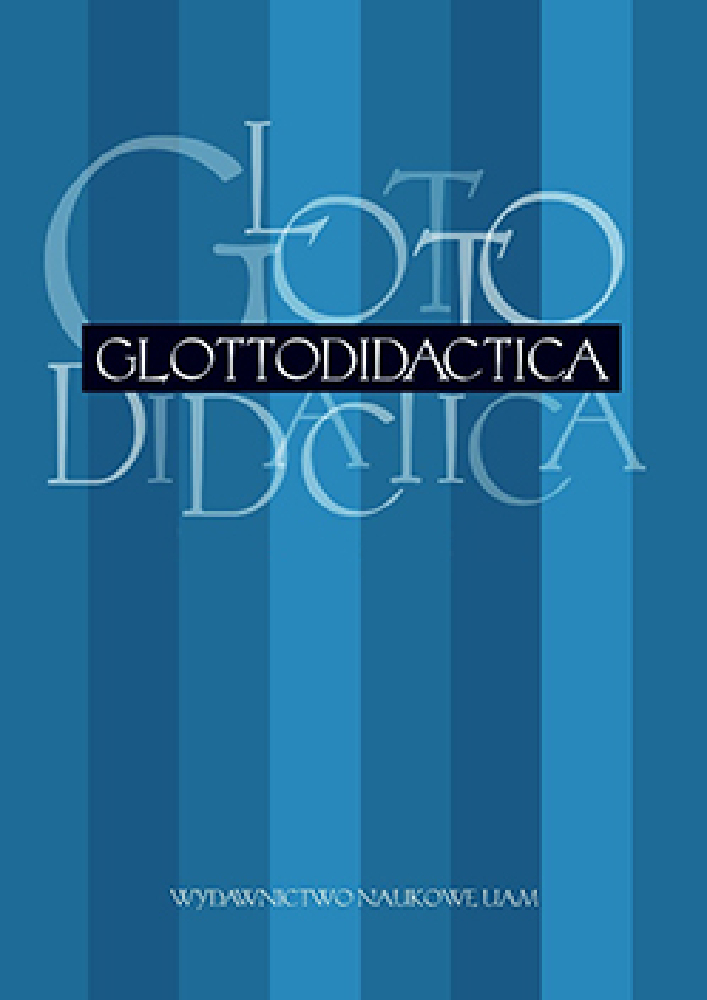Abstract
The aim of this paper is to discuss the role of turn-taking in dialogs of Polish and German schoolchildren aged from 13 to 15 years. The paper begins by describing the project and briefly viewing the most relevant definitions (e. g. turn, backchannels, segments). The next section presents the notation system and the methods. The samples were selected from the BORDERLAND data bank and, in total, they included nine pairs and over 1,000 segments. On this basis, it can be concluded that turn-taking in uniform pairs (Polish-Polish and German-German) is more defensive, and that the interlocutors tend to use more segments. There might also be a slight tendency for Polish speakers to interrupt their interlocutors more frequently. The findings, based on our samples, also suggest that speaking a foreign language (as we can notice in the German-Polish pairs) usually means less competitive speaking, as well as fewer segments and turn-takings
References
Auer, P. / Selting, M. (2001). Der Beitrag der Prosodie zur Gesprächsorganisation. In: K. Brinker et al. (Hrsg.). Text- und Gesprächslinguistik. HSK 16.2. (S. 1122–1131). Berlin / New York: de Gruyter. DOI: https://doi.org/10.1515/9783110169188.2.17.1122
Brinker, K. / Sager, S. (2010). Linguistische Gesprächsanalyse. Eine Einführung. Berlin: Erich Schmidt Verlag.
Couper-Kuhlen, E. / Selting, M. (2018). Interanctional linguistics. Studying language in social interaction. Cambridge: Cambridge University Press.
Gravano, A. / Hirschberg, J. (2010). Turn-taking cues in task-oriented dialogue. Computer Speech and Language, 25 (2011), 601–634. DOI:10.1016 / j.csl.2010.10.003. DOI: https://doi.org/10.1016/j.csl.2010.10.003
Henne, H. / Rehbock, H. (2001). Einführung in die Gesprächsanalyse. 4. durchgesehene und bibliographisch ergänzte Auflage. Berlin / New York: de Gruyter. DOI: https://doi.org/10.1515/9783110906189
Karpiński, M. (2006). Struktura i intonacja polskiego dialogu zadaniowego. Poznań: Wydawnictwo Naukowe UAM.
Karpiński, M. / Czoska, A. / Jarmołowicz-Nowikow, E. / Juszczyk, K. / Klessa, K. (2018). Aspects of gestural alignment in task-oriented dialogues. Cognitive Studies / Études cognitives, 18. https://doi.org/10.11649/cs.1640 [Zugriff am: 1.08.2019]. DOI: https://doi.org/10.11649/cs.1640
Karpiński, M. / Klessa, K. (2018). Methods, tools and techniques for multimodal analysis of accommodation in intercultural communication. Computational Methods in Science and Technology, 24 (1), 29–41. DOI: https://doi.org/10.12921/cmst.2018.0000006
Klessa, K. (2016). Annotation Pro. Enhancing analyses of linguistic and paralinguistic features in speech. Poznań: Wydział Neofilologii Uniwersytet im. Adama Mickiewicza w Poznaniu.
Klessa, K. / Karpiński, M. / Wagner, A. (2013). Annotation Pro – a new software tool for annotation of linguistic and paralinguistic features. In: D. Hirst / B. Bigi (Hrsg.). Proceedings of the tools and resources for the analysis of speech prosody (TRASP) workshop (S. 51–54). Aix-en-Provence Labratoire: Parole et Langage.
Levinson, S. (2016). Turn-taking in human communication – origins and implications for language processing. Trends in Cognitive Sciences, January 2016, Vol. 20, No. 1, 6–14. http://dx.doi.org/10.1016/j.tics.2015.10.010 [Zugriff am: 31.08.2019]. DOI: https://doi.org/10.1016/j.tics.2015.10.010
Mroczynski, R. (2014). Gesprächslinguistik. Eine Einführung. Tübingen: Narr.
Rath, R. (2001). Gesprächsschritt und Höreraktivitäten. In: K. Brinker / G. Antos / W. Heinemann / S. F. Sager (Hrsg.). Text- und Gesprächslinguistik. HSK 16.2. (S. 1213–1226). Berlin / New York: de Gruyter. DOI: https://doi.org/10.1515/9783110169188.2.18.1213
Sacks, H. / Schegloff, E. / Jefferson, G. (1974). A simplest systematics for the organization of turntaking for conversation. Language, 50, 696–735. DOI: https://doi.org/10.1353/lan.1974.0010
Schmitt, R. (2005). Zur multimodalen Struktur von Turn-taking. Gesprächsforschung, 6, 17–61. www.gespraechsforschung.ozs.de [Zugriff am: 31.08.2019].
Selting, M. (1996). On the interplay of syntax and prosody in the constitution of turn-constructional units and turns in conversation. Pragmatics, 6, 3, 357–388.
Selting, M. (2000). The construction of units in conversational talk. Language in Society, 29 (4), 477–517. https://www.jstor.org/stable/4169050 [Zugriff am: 31.08.2019]. DOI: https://doi.org/10.1017/S0047404500004012
Wittenburg, P. / Brugman, H. / Russel, A. / Klassmann, A. / Sloetjes, H. (2006). ELAN: A professional framework for multimodality research. In: N. Calzolari / K. Choukri / A. Gangemi / B. Maegaard / J. Mariani / J. Odijk / D. Tapias (Hrsg.). Proceedings of the 5th Language Resources and Evaluation Conference (S. 1556–1559). Genoa: ELRA.
License

This work is licensed under a Creative Commons Attribution-NoDerivatives 4.0 International License.
Authors
Authors of texts accepted for publication in Glottodidactica are required to complete, sign and return to the Editorial team’s office the Agreement for granting a royalty-free license to works with a commitment to grant a CC sub-license.
Under the agreement, the authors of the texts published in Glottodidactica grant Adam Mickiewicz University in Poznań a non-exclusive, royalty-free license and authorize the use of Attribution-NoDerivatives 4.0 International (CC BY-ND 4.0) Creative Commons sub-license.
The authors retain the right to the free disposal of the work.
Users
Interested Internet users are entitled to use works that have been published in Glottodidactica since 2016, under the following conditions:
▪ attribution – obligation to provide, together with the distributed work, information about the authorship, title, source (link to the original work, DOI) and the license itself.
▪ no derivatives – the work must be preserved in its original form. Without the author's consent, it is not possible to distribute the modified work in the form of translations, publications, etc.
Copyrights are reserved for all texts published before 2016.
Miscellaneous
Adam Mickiewicz University in Poznań retains the property right as a whole (layout, graphic form, title, cover design, logo etc.).
Privacy statement
The names and email addresses published on this journal site will be used exclusively for the purposes declared by this journal and cannot be used for any other purpose or by any other party.





